 “Halt!” called out the border guard. I stopped my cart, ignoring my horse’s protests.
“Halt!” called out the border guard. I stopped my cart, ignoring my horse’s protests.
A guard with “Hello, my name is TONY” sewn into his leather jerkin stepped out of the guardhouse. “You are attempting to leave our blessed land of Dicearefunville. I cannot allow it!”
“Why is that?” I queried.
“War has erupted in the neighboring land of Boringcubeopolis! The twin brothers Andrew and Chris cannot agree on the perfect cube size. It is not safe for you to pass!” Before I could ask another question, he disappeared into the guardhouse, quickly reappearing with a giant box in his hand.
“What is… Bardsung?” I asked, squinting to read the name on the box.
“It is a game that will not only entertain you but will also dissuade you from ever entering Boringcubeopolis again.” He leaned in conspiratorially and whispered, “It is said those that enter fall into an endless dreaming state of converting resources and moving cubes… I would not wish that upon my worst enemy!”
He handed me the enormous box and stepped back. My cart sunk into the dirt.
“So, in the name of Dicearefunville, please accept this gift and return home.” I complied, my horse neighing angrily at the added weight of the cart.
That is the true story of how I received my copy of Bardsung.
Gameplay Overview:
Bardsung is a cooperative fantasy campaign dungeon crawler for one to five players. For this review, I played games with three players.
The campaign is sprawling, with choices leading to different Chapters (quests), so all 31 Chapters will not be experienced in a single playthrough. Chapters take a varied amount of time because they are made up of Nodes (dungeons) that are explored non-linearly. Each Node takes about 60 to 90 minutes to complete.
Nodes, of which there are several types, are made up of several rounds, with each round made up of turns. Each turn follows the Marching Order (initiative track), with players or enemies taking their turn. During their turn, players will move, attack, and take actions while monsters will follow their AI and try to eliminate the heroes. If you have played dungeon crawlers with an initiative track, there is nothing groundbreaking here.
This repeats until either the heroes complete the Chapter or they die. If they complete the Chapter, instructions will be given on the next step of their adventure.
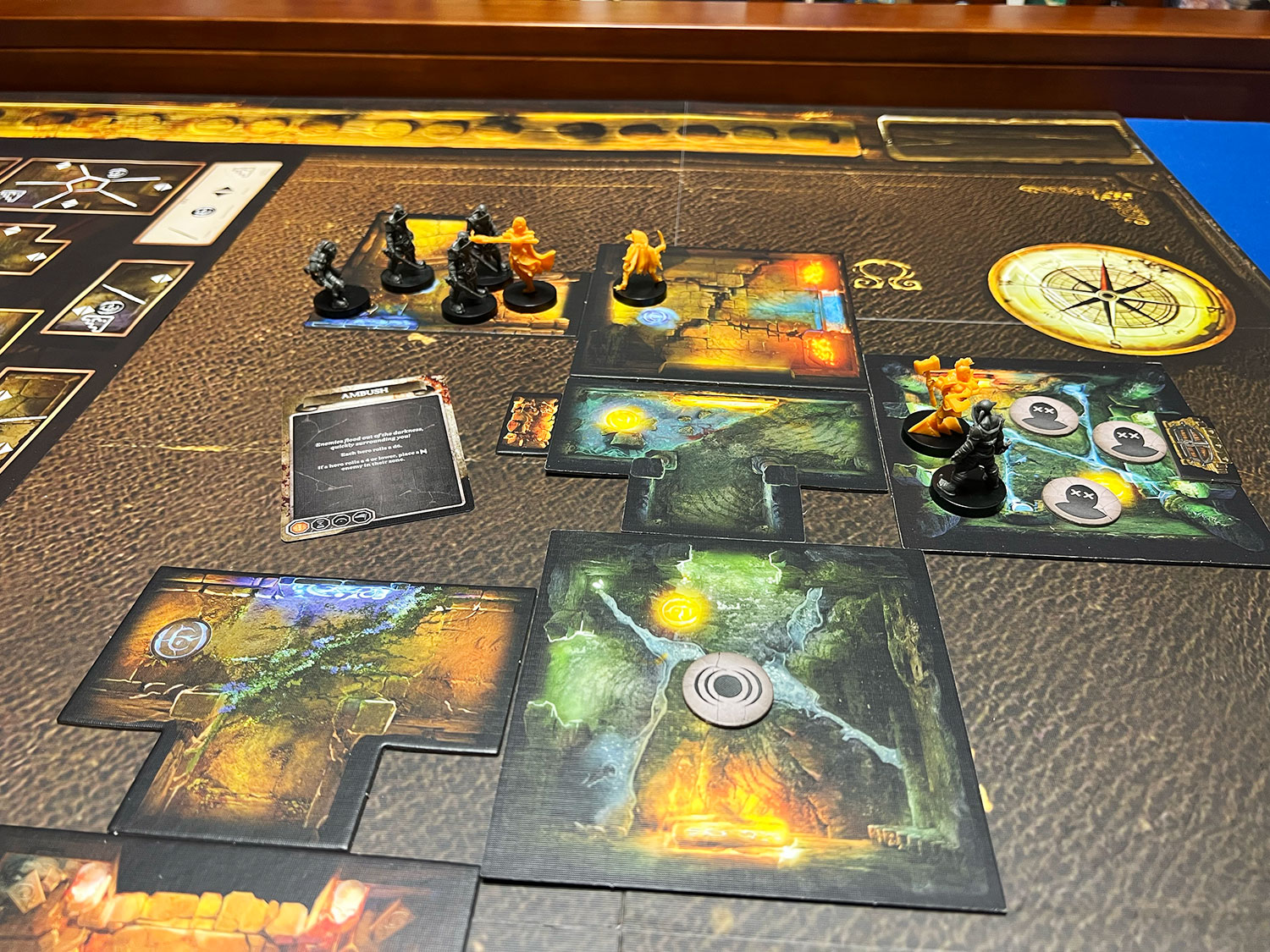
Game Experience:
I cannot remember reviewing a game that had so many great qualities while simultaneously having downsides to those same qualities.
Customization
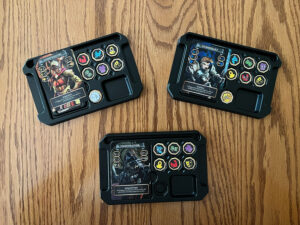
The options to customize your character are plentiful. Every character starts with three abilities, one weapon, one piece of armor, ten unlearned abilities, and six characteristics. ALL of these can be purchased/upgraded with XP earned during the campaign. Beyond that, you can purchase the abilities of any OTHER character (there are a few exceptions). There are so many paths to choose from—do you buy several abilities to expand your options or do you invest in the abilities you already have, making them stronger? Do you want to try to multiclass or stick to your kit?
but…
Several of the upgrades are obvious to take. Each character has a characteristic that drives their skills. That characteristic should be updated to +4 (the max), as this directly adds to rolls when using those skills. You can pretty much ignore the other five characteristics because the only time they would be utilized would be a) on skill checks outside of combat, which are not nearly as prevalent or b) if you choose to multiclass. You should also upgrade the skill you are using the most as well as your weapon to maximize your combat efficiency. After that, you can start spreading out the xp to new skills. Unfortunately, you will be several Chapters in before beginig to explore the other skills, unless you intentionally do not make the best improvements. I really wish that the five non-primary characteristics had more impact on the game, allowing even more choices.
Random Dungeons
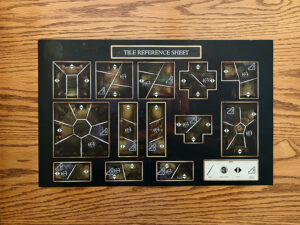
The random dungeons are fun to play through. You do not have the issue in Gloomhaven where you know the layout at the start of the Node. You draw a card, alternating between a corridor and a room, and place the tile that is on the card. The card will tell you what spawns in the room as well as which type of aspect card to draw: battle or challenge. Battle aspects impact the fight that is about to happen (they will be on all tiles that spawn enemies), while challenge aspects present you with a situation to address, like rescuing a trapped NPC or avoiding waking up wounded NPCs. This presents some variability to the numerous Nodes you will be exploring.
but…
Due to the random nature of these dungeons, the individual dungeons do not have a story outside of the overarching theme of the Chapter you are playing, combined with the narratives that some nodes reveal once completed. You are placing corridor A next to room A, followed by corridor B and room B, etc. The tiles are generic and can detract from the dungeon. I had rooms that looked like swamps next to temple tiles next to ones with a mechanical theme. Also, the zones (spaces) on each tile are not clear. In fact, SFG included a “Tile Reference Sheet” to refer to if the zones are not obvious.
Combat
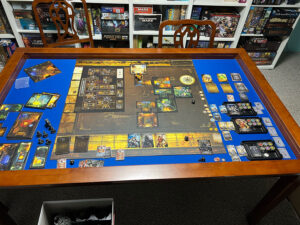
There is a LOT of combat in Bardsung, and the combat is different than most dungeon crawlers. You roll a d20 (D&D flashbacks incoming) for every attack and when being attacked. Every monster has a Target Number (TN). The TN is utilized for both when your character attacks the monster (to hit a monster, you have to roll higher than the TN) or when the monster attacks you (if you roll higher than their TN, you avoid the attack). If you hit, you check for a critical hit by rolling the damage die your character uses and comparing it to the monster’s toughness–if it is a higher, you made a critical hit. As you get more skills and improved skills your options open up even more. Finally, there is the Fate system. You can spend a Fate to activate more powerful abilities or empower your attacks. In addition, each character has a unique trigger to refresh spent Fate. Balancing when to use Fate and when to hold onto it in case of emergency is part of the fun.
but…
Combat can get repetitive. There are many monsters, but each Chapter is limited to five monsters (they can change, but RARELY do). Every monster has two or four hit points, except for bosses. When a monster has two wounds, it is either killed or flipped to its “heat up” side. Once you do two more damage, THEN the heated-up monster dies. Monsters do have AI, but it is simplistic and limited to one of eleven types and these types are tied to the monster (i.e. they are not random). Again, because the monsters do not change, you will see the same behavior from the same enemies tile after tile, outside of battle aspect card adjustments. Additionally, they still will only have, for the most part, two or four hit points, so one-shotting is commonplace as you progress.
Rules
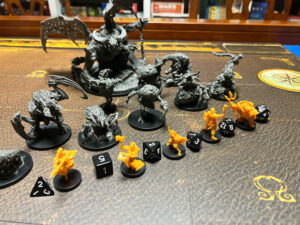
The rules are easy to grasp once you comprehend them. This is one of the easiest dungeon crawlers I have played. The rules are streamlined, but not boring. After a dungeon or two, you will hardly have to look rules up.
but…
Learning the rules can be difficult. Two books are included in Bardsung: a rulebook, which includes the basic rules and two excellent tutorials, and an adventure book containing mostly the Chapters and narrative paragraphs for the campaign. Unfortunately, more detailed rules or exceptions can be spread between either book. Finding these details can be frustrating (SFG provided an Index on their website but I did not find this until after I had mostly mastered the rules).
Final Thoughts:
I liked Bardsung. I really liked the characters and the progression options you have. I also enjoyed the combat and fate system. I THOUGHT I would LOVE the Node system. And I did… until I played the game multiple times across several weekends. It became repetitive.
I wanted to LOVE Bardsung. But I can only say I liked it. I recommend this as a try before you buy before due to its high cost.
Final Score: 3.5 Stars – A decent dungeon crawler that missed greatness due to repetition
 Hits:
Hits:
• Replay value high due to different paths, random dungeons and aspect cards
• Enjoyable combat/fate system
• Open ended customization
• Chapter/Node system is good but…
Misses:
• Chapter/Node system can be repetitive due to monster limitations
• Loot is underwhelming
• Rules are difficult to grasp at first
• Did I mention it can be repetitive?





















